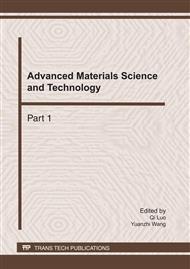p.189
p.195
p.201
p.206
p.212
p.220
p.226
p.230
p.236
Optical Nonlinearities of Epitaxial KTa0.65Nb0.35O3 Thin Films Grown by Pulsed Laser Deposition on (100) SrTiO3
Abstract:
Perovskite KTa0.65Nb0.35O3 (KTN) thin films were grown by pulsed laser deposition (PLD) on single crystal SrTiO3 (100) substrates. X-ray diffraction (XRD) analyses illustrate epitaxially grown of KTN thin films along the (100) orientation. The surface morphology of films observed by atomic force microscope (AFM) showed that, the surface of films was smooth and uniform built from regular, ordered and dense grains with the root mean square (RMS) roughness of 5.602 nm. Linear and third-order nonlinear optical properties of the films were investigated by using transmission spectra as well as the Z-scan technique with femtosecond laser pulses, respectively. The open-aperture and closed-aperture Z-scan curves of KTN thin films were obtained in the first measurement. The calculated nonlinear refractive index was , the nonlinear absorption coefficient is = , and the real part and imaginary part of the third order nonlinear susceptibility are and respectively.
Info:
Periodical:
Pages:
212-219
Citation:
Online since:
January 2011
Authors:
Price:
Сopyright:
© 2011 Trans Tech Publications Ltd. All Rights Reserved
Share:
Citation:


